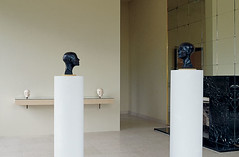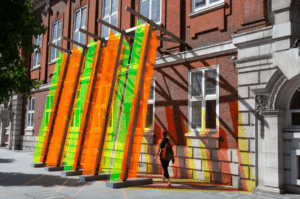
Christine Borland, Second Class Male, Second class female, 1996. Collection of Howard and Donna Stone.
The Fruitmarket Gallery will present Christine Borland, on view December 2 through January 28, 2007. The Fruitmarket Gallery is delighted to announce a major exhibition of work by Christine Borland. This exhibition brings together a selection of existing, recent, and newly commissioned work, offering an opportunity to trace the development of Borland’s ideas across the range of her practice.
Christine Borland makes art which deals with the body, and with our emotional, imaginative, medical and historical sense of self. Her practice is hugely varied, yet it is united by a number of constants. Chief among these is an insistent interrogation of objects and situations which shed light on the junction between the fact of the body and the more imaginative or conceptual construct of the self: the mechanics and the mystery of human existence. The kind of objects with which Borland works tend to be those with a close practical, imaginative or symbolic relationship to the human body. Shoes, blankets, slippers, crockery, bones and cell cultures have all featured in her work, as have objects with more elliptical associations, such as diamonds, birds, guns, apples, watermelons, leaves, plants and trees.
Borland’s exhibition at The Fruitmarket Gallery opens with a series of sculptures examining the frailty of the human condition through the fragility of the human body. In the mid 1990s, Borland discovered that it was possible to purchase human skeletons mail order.
Simultaneously fascinated and horrified by this, she made a number of works which seek to honour and recuperate the lost souls whose skeletal remains were acquired through the post. Second Class Male, Second Class Female, 1996 reconstructs in bronze the heads of the last two skulls obtained by the suppliers which the artist used; while Supported, 1990–1999, reclaims a fragile image from a skeleton by tracing its outline in dust on a glass shelf. These works are presented in the context of several others, including Bullet Proof Breath, 2001, a glass representation of human bronchia wound around with spider silk, which offer alternative ways of depicting and imagining the human body.
A sense of human knowledge unites the new work in the exhibition, which takes the natural world as its point of origin. The apple tree that provided Isaac Newton with his revelatory moment, and the plane tree on the island of Kos, under which Hippocrates, the founder of modern medicine, is said to have taught, reverberate through the history of man’s understanding of his place in the world. Borland has worked directly with both trees to make new sculptures for the exhibition, though neither is represented in its actual form. Accentuating the imaginative power of these trees, their position as the natural guardians of human endeavour, Borland summons only their symbolic presence.
Ultimately, Christine Borland’s art is concerned with re-visualising that which is no longer there. Finding ways imaginatively to cross back over the line dividing the body from the self – the specimen from the individual – she seeks to recuperate something of the essence of human life.
Christine Borland is one of Scotland’s most internationally important artists, trained at Glasgow School of Art and part of the generation that includes Douglas Gordon, Simon Starling and Roderick Buchanan. She has shown widely internationally, was included in the last Sculpture Projects Munster and was nominated for the Turner Prize in 1997.








